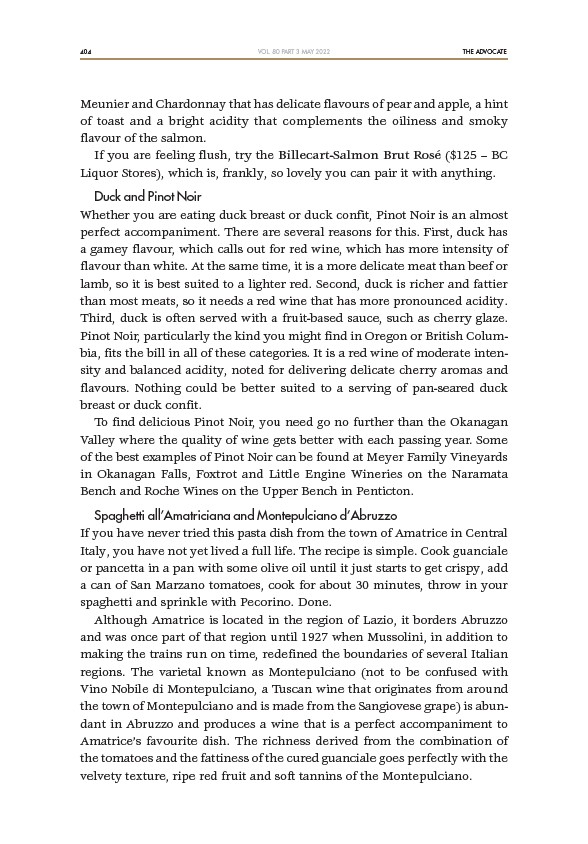
404 THE ADVOCATE
VOL. 80 PART 3 MAY 2022
Meunier and Chardonnay that has delicate flavours of pear and apple, a hint
of toast and a bright acidity that complements the oiliness and smoky
flavour of the salmon.
If you are feeling flush, try the Billecart-Salmon Brut Rosé ($125 – BC
Liquor Stores), which is, frankly, so lovely you can pair it with anything.
Duck and Pinot Noir
Whether you are eating duck breast or duck confit, Pinot Noir is an almost
perfect accompaniment. There are several reasons for this. First, duck has
a gamey flavour, which calls out for red wine, which has more intensity of
flavour than white. At the same time, it is a more delicate meat than beef or
lamb, so it is best suited to a lighter red. Second, duck is richer and fattier
than most meats, so it needs a red wine that has more pronounced acidity.
Third, duck is often served with a fruit-based sauce, such as cherry glaze.
Pinot Noir, particularly the kind you might find in Oregon or British Columbia,
fits the bill in all of these categories. It is a red wine of moderate intensity
and balanced acidity, noted for delivering delicate cherry aromas and
flavours. Nothing could be better suited to a serving of pan-seared duck
breast or duck confit.
To find delicious Pinot Noir, you need go no further than the Okanagan
Valley where the quality of wine gets better with each passing year. Some
of the best examples of Pinot Noir can be found at Meyer Family Vineyards
in Okanagan Falls, Foxtrot and Little Engine Wineries on the Naramata
Bench and Roche Wines on the Upper Bench in Penticton.
Spaghetti all’Amatriciana and Montepulciano d’Abruzzo
If you have never tried this pasta dish from the town of Amatrice in Central
Italy, you have not yet lived a full life. The recipe is simple. Cook guanciale
or pancetta in a pan with some olive oil until it just starts to get crispy, add
a can of San Marzano tomatoes, cook for about 30 minutes, throw in your
spaghetti and sprinkle with Pecorino. Done.
Although Amatrice is located in the region of Lazio, it borders Abruzzo
and was once part of that region until 1927 when Mussolini, in addition to
making the trains run on time, redefined the boundaries of several Italian
regions. The varietal known as Montepulciano (not to be confused with
Vino Nobile di Montepulciano, a Tuscan wine that originates from around
the town of Montepulciano and is made from the Sangiovese grape) is abundant
in Abruzzo and produces a wine that is a perfect accompaniment to
Amatrice’s favourite dish. The richness derived from the combination of
the tomatoes and the fattiness of the cured guanciale goes perfectly with the
velvety texture, ripe red fruit and soft tannins of the Montepulciano.